Freight shipping between China and the Philippines | Rates – Transit time – Duties & Taxes
Do you want to export from China to the Philippines? Perhaps you want to know every detail you may need to nail your freight shipping process between China and the Philippines.
Nothing is complicated, all that is required is a thorough examination of the various modes of transportation and documentation that must be provided. This guide will summarize the most crucial aspects of the Freight shipping process from China to the Philippines in detail.
What is the best method of transportation between China and the Philippines?
To begin with, we will compare the different existing modes of transport between China and the Philippines: sea freight and air freight.
We will give you the advantages and disadvantages of each of these modes of transportation. And we will guide you on your choice with advice according to different situations.
Docshipper Note:
Need assistance with your shipment? Dont hesitate to contact us even for a simple question. Choose the option that suits you
Live chat with an expert Chat us on WhatsApp Fill the form
DocShipper Tip:
Sea freight will be the best option if:
- You have a small budget.
- You ship at least 2CM of goods.
Sea freight from China to the Philippines
Ocean freight between China and the Philippines
Trade relations between China and the Philippines have a centuries-old history of fruitful and mutually beneficial exchanges. Maritime transport has played a key role in the development of these economic ties.
In recent decades, bilateral trade between the two countries has experienced remarkable growth, driven by economic expansion in both China and the Philippines.Sea freight has emerged as the preferred choice for moving a wide range of goods, including manufactured goods, raw materials, electronics, and everyday consumer goods. Major Chinese and Philippine ports have adapted to this growing demand by modernizing their infrastructure and introducing efficient procedures to facilitate sea transport operations.
This section will focus on sea freight between China and the Philippines, covering the main ports in both countries, transit times, the various types of containers used, and the associated transport costs.
Main ports of China
The port of Shanghai
![]() The Port of Shanghai, is the world’s largest container port, with a cargo capacity of over 40 million twenty-foot equivalent units (TEUs) per year. In 2020, it handled over 43.5 million TEUs of cargo.
The Port of Shanghai, is the world’s largest container port, with a cargo capacity of over 40 million twenty-foot equivalent units (TEUs) per year. In 2020, it handled over 43.5 million TEUs of cargo.
The port of Ningbo-Zhoushan
 Ningbo-Zhoushan Port, is the second-largest container port in China, with a cargo capacity of about 30 million TEUs per year. In 2020, it recorded a cargo volume of nearly 28.8 million TEUs.
Ningbo-Zhoushan Port, is the second-largest container port in China, with a cargo capacity of about 30 million TEUs per year. In 2020, it recorded a cargo volume of nearly 28.8 million TEUs.
The port of Shenzhen
 The Port of Shenzhen, is one of China’s busiest ports, with a cargo capacity of about 25 million TEUs per year. In 2020, it handled more than 25.2 million TEUs of cargo.
The Port of Shenzhen, is one of China’s busiest ports, with a cargo capacity of about 25 million TEUs per year. In 2020, it handled more than 25.2 million TEUs of cargo.
The port of Tianjin
![]() Tianjin Port, is one of the country’s largest ports, with a cargo capacity of about 17 million TEUs per year. In 2020, it handled more than 17.6 million TEUs of cargo.
Tianjin Port, is one of the country’s largest ports, with a cargo capacity of about 17 million TEUs per year. In 2020, it handled more than 17.6 million TEUs of cargo.
The port of Qingdao
 Qingdao Port, with a cargo capacity of about 18 million TEUs per year and a cargo volume of nearly 18.5 million TEUs in 2020.
Qingdao Port, with a cargo capacity of about 18 million TEUs per year and a cargo volume of nearly 18.5 million TEUs in 2020.
Philippine ports
The Port of Manila
He’s a major seaport in Manila Bay, Philippines. It is one of the most important ports in the Asia-Pacific region in terms of cargo volume handled.
The Port of Manila plays a crucial role in trade between the Philippines and China. Due to its strategic geographical position, it serves as an essential gateway for trade between the two countries. It facilitates the transport of goods such as electronics, textiles, automotive parts, foodstuffs and many others.
The geographical proximity between Manila and China enables a fluid flow of trade, promoting economic exchanges and strengthening bilateral relations. Imports from China are routed via the Port of Manila to the Philippines, while Philippine exports to China also pass through this port.
The Port of Cebu
It is one of the Philippines’ most important ports, located in the city of Cebu. It plays a crucial role in the region’s economic development and is considered a vital maritime hub in Southeast Asia.
The Port of Cebu is strategically positioned as a hub for trade and logistics between the Philippines and other countries. It boasts a modern infrastructure, well-equipped quays, and well-organized terminals to accommodate ships of all sizes.
In terms of its importance to China, the Port of Cebu plays a key role in strengthening economic ties between the two countries. China is one of the Philippines’ major trading partners, and the Port of Cebu facilitates the transport of goods between the two nations. Many Chinese products are imported through the Port of Cebu, contributing to economic growth and bilateral trade.
The Port of Davao
Located in the province of Davao del Sur in the Philippines, it is an important seaport in the Mindanao region. It is considered the third-busiest port in the country.
In terms of its importance to China, the port of Davao plays a significant role in trade between the Philippines and China. China is one of the Philippines’ main trading partners, and Davao is one of the key ports used to facilitate this trade.
Chinese investments have modernized and developed Davao’s port infrastructure, consolidating bilateral trade and economic ties. It thus plays a key role in trade relations between China and the Philippines.
The port of Subic Bay
It is of great geostrategic importance due to its proximity to China. Indeed, it is located relatively close to the vital shipping lanes of the South China Sea. This region is a crucial transit point for international trade and the transport of goods to and from China.
In addition, the port of Subic Bay plays a key role in trade between China and ASEAN (Association of Southeast Asian Nations) countries. It provides a logistical platform to facilitate imports and exports between these regions, strengthening economic and trade ties between China and Southeast Asian countries.
The Port of Batangas
It is one of the most important ports in the Philippines. Located in the province of Batangas, it plays a crucial role in the country’s maritime trade.
With regard to the importance of the Port of Batangas with China, it should be noted that China is a key trading partner for the Philippines. The Port of Batangas is a crucial link in trade between the two countries, enabling the efficient transport of goods between Chinese and Philippine ports.
How much time does it take ship from China to the Philippines
Above is a table showing the average transit times between the main ports in China and the main ports of the Philippines.
| Shanghai | Ningbo-Zhoushan | Shenzhen | Tianjin | Qingdao | |
| Manilla | 10 days | 4 days | 9 days | 12 days | 11 days |
| Cebu | 11 days | 4 days | 10 days | 13 days | 12 days |
| Davao | 12 days | 4 days | 11 days | 14 days | 13 days |
| Batangas | 10 days | 4 days | 9 days | 12 days | 11 days |
These transit times are given as an indication and may vary slightly.
Should I ship by groupage or full container between China and Philippines?
There are different types of containers, but the three most commonly used are:
- The 20-foot container has a capacity of 33 CBM.
- The 40-foot container has a capacity of 67 CBM.
- The 40-foot HQ container with a capacity of 76 CBM.
For each type of container, two different shipping methods can be used.
Maritime consolidation or LCL (Less than Container Load)
Maritime consolidation allows you to send goods when you do not have enough cargo to fill an entire container. The rest of the available space will then be used by other customers. This saves money when you send a quantity of goods less than 15 CBM.
FCL (Full Container Load)
Full container load, as the name suggests, involves filling a container with the goods of one person. Note that it is not necessarily necessary to fill the entire container. From 15 CBM, your shipment will be profitable.
Advantages of Maritime Consolidation
- More cost-effective for shipments under 15m3.
- Possibility to ship small quantities of goods more often and therefore save on storage costs.
Disadvantages of Maritime Consolidation
- There is a higher potential for loss or damage to your goods as a result of frequent container openings.
- There is a chance of longer transit times due to the loading and unloading of goods from various customers.
Advantages of FCL
- It offers a greater cost advantage for shipments exceeding 15 CBM.
- It provides enhanced safety as the container remains sealed throughout the entire journey.
- It ensures faster transit times as there are typically no intermediate stops along the way.
Disadvantages of FCL
- A minimum volume of 15m3 to be profitable.
- Often requires advance planning, as containers must be reserved and scheduled for loading in advance.
DocShipper Advice
We advise you to opt for sea freight if your shipment is over 2 cubic meters. Whether you choose the LCL or FCL shipping method, we can handle your shipment. Do not hesitate to contact us!
How much does sea freight cost between China and the Philippines?
The cost of sea freight between China and the Philippines can vary depending on several factors, including the volume of goods, the type of cargo, the chosen shipping method, and the specific route. Additionally, freight rates are subject to market fluctuations and other external factors. Fill out our form with the necessary information and receive a free quote in less than 24 hours!
Tariff surcharges
Here are some common tariff surcharges that may be applicable in the Philippines :
- Bunker Adjustment Factor (BAF): This surcharge accounts for the fluctuating cost of fuel (bunker fuel) used in shipping vessels. It helps shipping lines offset the impact of fuel price changes.
- Peak Season Surcharge (PSS): This surcharge is applied during peak shipping seasons when demand for container space is high. It helps shipping lines manage capacity and balance supply and demand.
- Currency Adjustment Factor (CAF): This surcharge addresses currency exchange rate fluctuations between the booking currency and the currency in which the shipping costs are invoiced.
- Emergency Risk Surcharge (ERS): This surcharge may be imposed during periods of unforeseen events or emergencies that can impact shipping operations, such as natural disasters or geopolitical disruptions.
- Low Sulfur Surcharge (LSS): This surcharge is introduced to comply with regulations requiring the use of low-sulfur fuel to reduce emissions. It covers the additional cost associated with using cleaner fuels.
- Congestion Surcharge: This surcharge is applied when there is congestion at a specific port or terminal, leading to delays and additional operational costs for shipping lines.
DocShipper info
If you would like to know the exact cost of your sea freight shipment between China and the Philippines, the easiest way is to fill in our contact form. You’ll receive a free quote in less than 24 hours!
DocShipper Tip:
Air freight will be the best option if:
- You have a volume of less than 2 m³.
- You want your goods to arrive quickly.
Airfreight from China to the Philippines
Classic or express air freight?
Air freight between the Philippines and China is a crucial mode of transportation for time-sensitive and high-value goods. The Philippines, with its strategic location and well-developed aviation infrastructure, serves as a major air cargo hub in the region.
Numerous airlines operate frequent flights connecting the Philippines and various cities in China. These flights provide efficient and speedy transport options for both imports and exports.
There are two different forms of air freight:
Conventional air freight: This option uses the space available on commercial aircraft and is used by airlines such as British Airways, Cathay Pacific, and Emirates to ship goods on scheduled flights.
Express air freight: With this second option, more expensive, items are transported by specialized freight operators such as DHL, FedEx, and UPS.
Airport of Hong Kong

What are the advantages of air freight?
- Air freight is the most efficient method of transporting products across great distances. It is great for time-sensitive shipments, since goods may be moved from one nation to another in a matter of hours or days.
- When it comes to delivery timings, airlines have a high level of dependability since they operate on a regular schedule and have fewer delays due to weather or road conditions.
- For important or sensitive products, air freight provides a high level of protection. Airports employ stringent security procedures to guarantee that cargo is not tampered with or destroyed while in transit.
What are the disadvantages of air freight?
- In general, air freight is more expensive than other types of transportation, such as sea freight or land freight. The high expense is attributable to air travel’s speed, security, and convenience.
- Weight and dimension restrictions on air freight may limit the sorts of items that can be delivered. Some airlines may also limit the sorts of things that can be transported, such as hazardous chemicals.
- When compared to other modes of transportation, air freight has a greater carbon footprint, contributing to global warming and climate change.
How much does air freight cost between China and the Philippines?
The cost of air freight between China and the Philippines depends on a number of factors, including the weight and size of the consignment, the distance between the airports, the urgency of delivery, and current market pricing.
Air freight rates are often computed on volumetric or gross weight, with the bigger of the two determining the shipping cost. The shipping cost might range from a few hundred dollars to several thousand dollars.
How to calculate the volumetric weight of your shipment?
The volumetric weight of a package is the volume occupied by it, depending on its dimensions and gross weight. To determine the volumetric weight, measure the package’s dimensions (length, breadth, and height) and then convert them to cubic meters. Then follow this formula:
Volumetric weight = (length x width x height) / 5000
(where 5000 is a standard conversion factor used in air freight)

Door-to-door delivery between China and the Philippines
The transportation of products from the place of origin to the ultimate destination, including the collection, transportation, and delivery of goods, is referred to as a door-to-door delivery service. Shippers benefit from this service since they no longer have to worry about the logistics of shipping their goods. E-commerce shipments, package deliveries, and other small to medium-sized items are frequently delivered door-to-door.
You may utilize specialist organizations like DocShipper China to take advantage of this service, which will manage the entire procedure for you. You may be confident that you will receive professional and high-quality service from our team of specialists and our global partners.
What are the advantages of door-to-door services?
- Shippers prefer door-to-door delivery because it streamlines the shipping procedure. The carrier handles the pickup, transportation, and delivery of goods, saving the shipper time and effort.
- Door-to-door delivery saves time since the shipper does not have to drop off the items at a transportation hub or terminal. The products will be picked up from the shipper’s location and delivered straight to the ultimate destination by the carrier.
- The carrier is responsible for transporting items from the place of origin to the ultimate destination, with door-to-door delivery. As the carrier is responsible for handling the items throughout the transit process, this decreases the chance of damage or loss during delivery.
DocShipper info
Door-to-door services are very useful: your products will arrive quickly, and you can be sure that your transport will go smoothly! Contact us to find out more.
Customs clearance between China and the Philippines
How can you find out which customs duties and taxes apply to your goods? All you need to know is the HS (Harmonized System) code! All member countries of the World Trade Organization have this HS code (composed of at least 6 digits). Each product has a different HS code depending on its characteristics. And thanks to this code, you can find out which customs duties and taxes apply to your product on the Hong Kong customs website.
Here’s what an HS Code is made of :
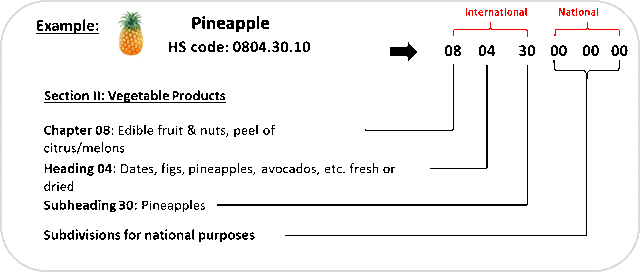
How can I find the HS code for my products?
Go to this page: HTS – HS Code Finder and enter your product name. All you need to do is check which HS code your product corresponds to in the results. In the following example we take the case of pineapple.
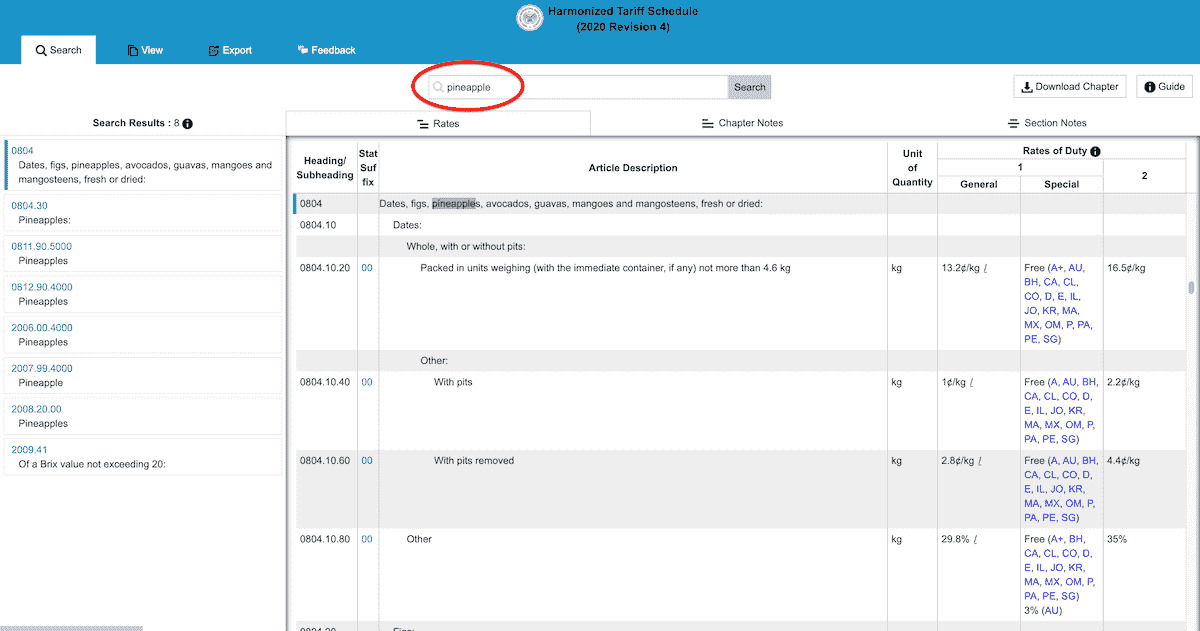
Calculation of customs duties with HS code
Once you have the HS code, you can easily find the duties and taxes that apply to your product;
As for customs clearance in China, just go to the China Customs page: China Customs Tariff.
Please enter your HS code on this page first:
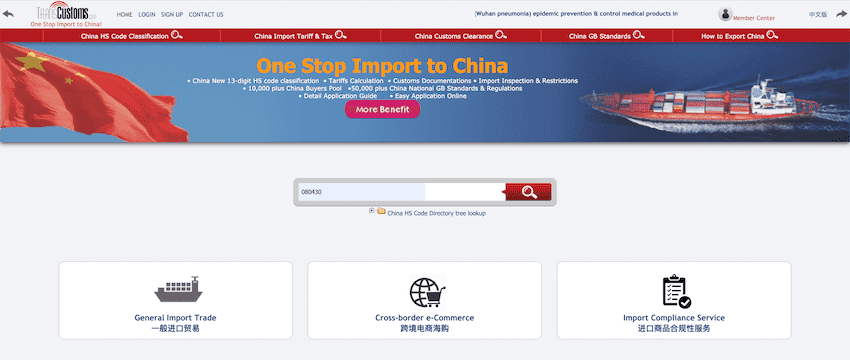
Click Search, and the results will look like this:

3 categories arise import tax and duty, customs declaration, and landed costs.
Let’s take a look at them:
- Import duties and Taxes in China
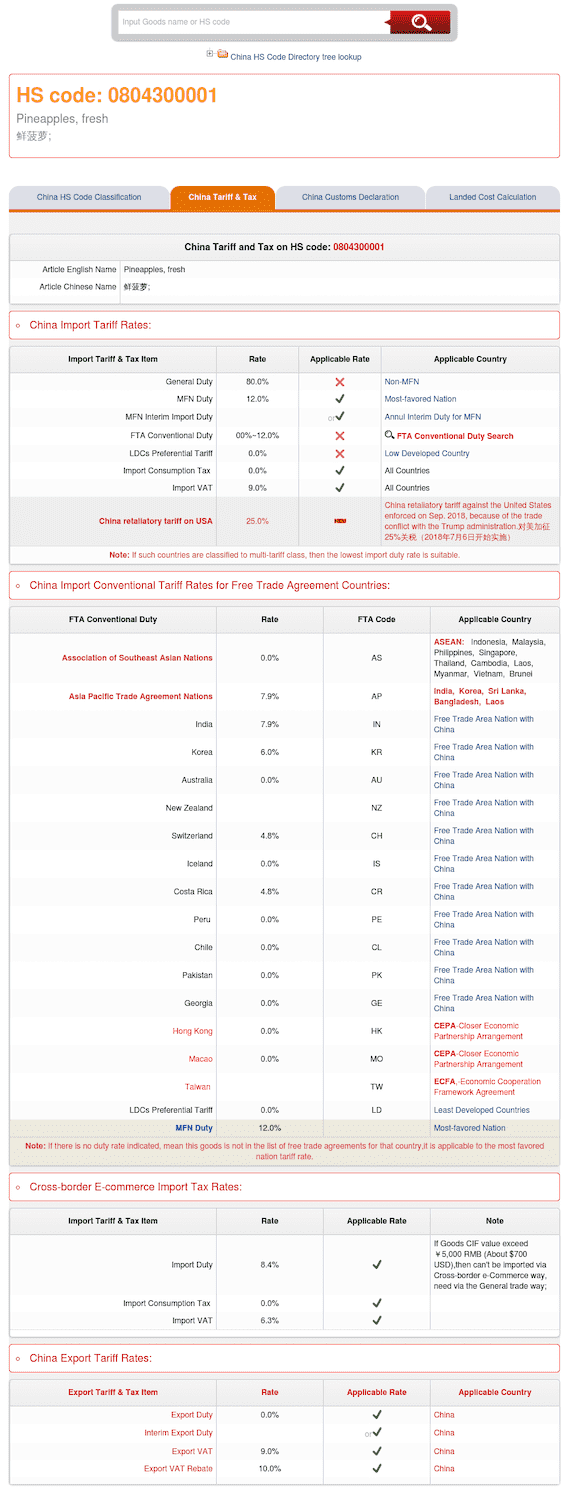
- Cost calculator for cash procurement in China
As we can see, if you import products falling into category 0804 30, you won’t pay customs duties when importing into China.
Does Docshipper charge customs duties?
No, DocShipper does not charge any commission on customs duties. DocShipper only collects customs clearance fees, as our professionals prepare the official documents to be shown to customs.
Customs procedure and contact
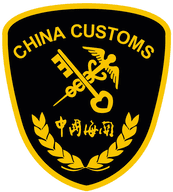
Chinese Customs
Name Official: General Administration of Customs people’s republic of China
Website Official: Chinese customs

The Philippines Customs
Official Name: Philippines customs and excise
Website Official: Bureau of Customs
What import and export licenses are required?
To import goods from China to the Philippines, you will need to fulfill certain licensing requirements. Here are the general steps and licenses required for importing goods:
- Business Registration: Register your business with the Philippine government. You need to obtain a valid Business Name Registration from the Department of Trade and Industry (DTI) if you are a sole proprietorship, or register as a corporation with the Securities and Exchange Commission (SEC) for other types of businesses.
- Importer’s Clearance Certificate (ICC): Apply for an ICC from the Bureau of Internal Revenue (BIR). This certificate is required for all importers and is used to validate your business and tax registration.
- Philippine Economic Zone Authority (PEZA) Registration (Optional): If you plan to operate within a PEZA-accredited zone, you may need to register with PEZA to avail yourself of certain incentives and benefits.
- Bureau of Customs (BOC) Registration: Register with the BOC by filing the necessary forms and providing the required documents. This step will provide you with a unique Business Identification Number (BIN) and enable you to engage in import activities.
- Importer’s Accreditation: Apply for importer’s accreditation from the BOC. This process involves submitting various documents such as your business registration, ICC, and other supporting requirements.
- Importer Clearance Certificate (ICC): Secure an ICC from the BOC by filing the necessary forms and paying the corresponding fees. The ICC is an official document that certifies the legitimacy of your importation activities.
- Payment of Duties and Taxes: Importation involves the payment of duties, taxes, and other fees. Ensure you comply with customs regulations and pay the necessary charges to facilitate the release of your imported goods.
Please note that specific import requirements may vary depending on the type of goods you are importing. It is essential to consult with the relevant government agencies, such as the BOC and DTI, or seek assistance from a customs broker or import consultant to ensure compliance with the latest regulations and procedures.
Other logistics services
Warehousing and storage
Thanks to the strategic locations of our warehouses, we'll be able to receive goods for as long as you need, then send them wherever you want, or have them delivered to Hong Kong. Our warehouses are ultra-secure, with 24-hour camera surveillance. Find out more on our dedicated page: Storage services
Transport insurance
The value of your insurance contract is determined by the value of your possessions. As you can see, the higher the value, the higher the insurance premium. In general, the following calculation is used: (freight value + product value) * 1-3 per cent. Therefore, you can rely on this calculation to make an informed estimate. This rate can be modified according to the nature/category of your goods. Find out more on our dedicated page: Insurance services

International moving services
Are you moving to Hong Kong, China, or another country? Whatever your destination, we can take care of your move and guarantee you a perfect international move! Find out more on our dedicated page: Moving services

Sourcing services
Are you looking for a verified Chinese supplier? Rely on our sourcing service to find the best supplier for your needs. Our network of over 2,000 verified suppliers and our experience in the field enables us to find you the right supplier quickly. Find out more on our dedicated page: Sourcing services
FAQ | Freight shipping between China and the Philippines | Rates - Transit Time - Duties and Taxes - Advice
It all depends on your expectations. Air freight will be faster than sea freight, but also more expensive.
Sea freight is recommended for quantities greater than 2 m3.
Yes, we can! Our vehicles collect your products from your manufacturer, and we consolidate them all in our warehouse.
Please note that we are able to provide this type of service in both LCL and FCL, so there are no volume restrictions.
Fill in our online form with the required information: volume, type of goods, departure address, arrival address…
Also, mention the nature of your goods to find out if we have any special documentation and packaging requirements for customs clearance.
The following items are commonly prohibited from import into the Philippines:
- Controlled substances like narcotics and drugs.
- Firearms and ammunition without proper permits.
- Offensive weapons like flick knives and pepper spray.
- Counterfeit goods, including fake designer items.
- Products made from endangered species.
- Hazardous materials and certain types of batteries.
- Obscene materials, including pornography.
- Copyright infringing goods, such as counterfeit branded products.
- Unlicensed pharmaceutical products.
- Certain food products may have specific regulations.
For the most accurate and up-to-date information, it's recommended to consult the Philippines Customs and Excise Department or relevant authorities.
For your business interest, you may like the following useful articles :
